About Samudragupta
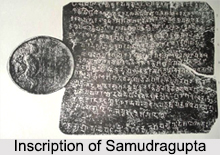 Samudragupta was a benevolent ruler who reigned from 335 to 380 BC. He was a great warrior and patron of arts. He was the son of Chandragupta I and probably the greatest king of Gupta dynasty. There is a detailed and authentic record of Samudragupta`s reign, which was composed by his court poet Harisena which is found in the rock pillar of Allahabad. He had to undergo a struggle for the throne with his elder brothers after his father`s death. Samudragupta ascended the throne and conquered almost whole of India. His greatest achievement was the political unification of most of the India into a unique power. Samudragupta took the title of Maha Rajadhiraja. After winning all the big battles, Samudragupta performed Ashwamedha Yajna or Horse sacrifice. Many rulers of foreign states like the Saka and Kushana kings accepted Samudragupta`s supremacy and offered him their services.
Samudragupta was a benevolent ruler who reigned from 335 to 380 BC. He was a great warrior and patron of arts. He was the son of Chandragupta I and probably the greatest king of Gupta dynasty. There is a detailed and authentic record of Samudragupta`s reign, which was composed by his court poet Harisena which is found in the rock pillar of Allahabad. He had to undergo a struggle for the throne with his elder brothers after his father`s death. Samudragupta ascended the throne and conquered almost whole of India. His greatest achievement was the political unification of most of the India into a unique power. Samudragupta took the title of Maha Rajadhiraja. After winning all the big battles, Samudragupta performed Ashwamedha Yajna or Horse sacrifice. Many rulers of foreign states like the Saka and Kushana kings accepted Samudragupta`s supremacy and offered him their services.
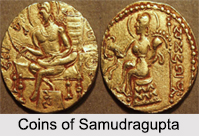 Monetary System under the Rule of Samudragupta
Monetary System under the Rule of Samudragupta
Samudragupta changed the monetary system of Gupta dynasty. He began the minting of eight different types of coins which included the standard type, the battle-axe type, the archer type, the Ashwamedha type, the tiger slayer type, the king and queen type, the lyrist type and the kacha type. All these coins exhibited an extreme delicate sculptural and technical finesse. Much about Samudragupta is known through these coins issued by him. They were made of pure gold. The coin-making expertise was acquired from his acquaintance with the Kushans.
Inscriptions of Samudragupta
The inscriptions, which have been found from the Samudragupta"s reign, are Allahabad Pillar Inscription and Eran Stone Inscription. The inscriptions are written in fine Gupta script- a later version of Brahmi. The inscriptions describe the political and military achievements of Samudragupta and praise the Gupta emperor and his reign. The other two inscriptions are Nalanda Inscription and Gaya Inscription, though they are much disputed about their time of writing.
Personality of Samudragupta
Samudragupta was a great warrior as well as an openhearted person. He showed great magnanimousness towards the kings who were defeated in the battle. He allowed various tribal states for autonomous rule under his protection. He is known to have been a man of culture. He was a celebrated poet and a musician. His court was full of poets and scholars. Samudragupta had a keen interest in music and he himself was probably a renowned lyrist. His coins depict him playing the Veena. He took effective actions to propagate religious, artistic and literary aspects of Indian culture. Though he followed Hinduism like the other Gupta kings, he was well known for his tolerant spirit towards other religions. This was proved when he gave permission to the king of Ceylon to build a Buddhist monastery for the pilgrims in Bodh Gaya. After the death of Samudragupta, his son Chandragupta II or Vikramaditya was enthroned who reigned from 380 to 413 AD and the Gupta Dynasty still flourished with its glory and prosperity under his rule.
Conquests of Samudragupta
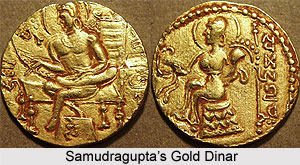 The conquests of Samudragupta had given him the title `Alexander of India`. Such an enormous conquest was guided by the sole aim of Samudragupta to bring about a political unification of India under his own supremacy and himself becoming the Ekrat or the sole ruler. Samudragupta set out to expand the boundary of his kingdom and adopted the policy of "Digvijay". The Allahabad Prasasti delineates a vivid description of Samudragupta`s military campaigns.
The conquests of Samudragupta had given him the title `Alexander of India`. Such an enormous conquest was guided by the sole aim of Samudragupta to bring about a political unification of India under his own supremacy and himself becoming the Ekrat or the sole ruler. Samudragupta set out to expand the boundary of his kingdom and adopted the policy of "Digvijay". The Allahabad Prasasti delineates a vivid description of Samudragupta`s military campaigns.
According to the description provided by Harisena in the Allahabad Prasasti, it was clear that Samudragupta undertook two campaigns in Aryavarta or northern India. There are descriptions of those kings who had been defeated by Samudragupta during his military expedition in the northern and southern territories.
Scholars have opined that the conquests of Samudragupta can be broadly classified into four categories. The four categories are - his conquest against the kings of south, conquest against nine kings of Aryavarta, conquest against the Atavikas and the five frontier kingdoms and nine tribal states and lastly the conquests of some independent and semi-independent principalities in the remote areas. These kingdoms were compelled to offer allegiance and tribute to Samudragupta.
Samudragupta at first thoroughly subjugated the neighbouring kings in the Ganga Yamuna valley and consolidated his position in the north before he set out for his military conquest in the territories of south. Samudragupta defeated the kings Achyuta of Ahichchatra, Nagasena of Mathura and Ganapati Naga of Padmavati and also the prince of Kota family, who constituted a formidable resistance against Samudragupta. The region of Ahichchatra has been identified with Ramnagara and Bareilly district of Uttar Pradesh. Nagasena and Ganapati Naga were the Naga princes who ruled Mathura and Padmavati in Gwalior. The Kota family was concentrated in the Sarasvati region of Uttar Pradesh. Samudragupta routed the league formed by these allied powers in the battle of Kaushambhi. As a result he became the sovereign authority of the vast tract of Ganga Yamuna valley. He consolidated these kingdoms under his own supremacy and annexed it with the Gupta Empire. From Allahabad Prasasti composed by Harishena, it is known that he conducted the military operation in Aryavarta from the region of Purushpura.
A great conqueror, Samudragupta brought political unification within India. He set out for the conquest of southern India or Deccan. Historians have opined that Samudragupta personally did not lead in all campaigns. Being a shrewd diplomat, Samudragupta deviated from the policy of Digvijay in Deccan or south India. In his southern campaign Samudragupta followed in the footsteps of the Mauryan Emperor Ashoka, i.e. the policy of Dharmavijaya. It was guided by three principles: `grahana (capture of the enemy), `moksha` (liberating him) and `anugraha` (favouring him by reinstatement of his kingdom). He did not annex the kingdoms of the local rulers of Deccan; rather he reinstated their kingdom under his own authority. However the historians have different theories regarding his conquests in South India.
Samudragupta defeated as many as twelve kings in course of his campaigns in south India or The Deccan. The identification of the kings defeated by Samudragupta proves that his sway extended in eastern Deccan also. He defeated the kings of Kosala, Mahakantara, Kaurala, Pistapuram, Kottura, Erandapalla, Kanchi, Vengi, Avamukta, Palakka, Devarashtra and Kushalapura.
Samudragupta further extended the boundary of his Empire by conquering the Atavika kingdoms from the forest kings. Atavika or the forest kingdoms extended from the regions of Ghazipore district in Uttar Pradesh to Jabalpore in Madhya Pradesh. The sweeping conquest of Samudragupta in north and south made him the paramount ruler in India. There were five kingdoms and nine tribal states on the frontier, which became his vassals and paid him tribute, obeyed his orders and offered him homage. Apart from these, several tribal states also became his vassal, which included Samatata, Davaka, Kamrup, with Guwahati district. Among those tribal states mention may be made of the Arjunayas, Madrakas and Yaudheyas.
Conquests of Samudragupta in South India
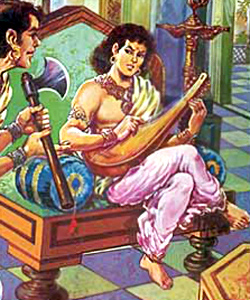 Conquests of Samudragupta in South India according to some historians disclose that he was opposed by a confederacy of kings of the Eastern Deccan near the Colair Lake. This made him abandon his conquests in the coast of Orissa and returned home. The Allahabad record however clearly shows that Samudragupta advanced in the south. The Prasasti of Harisena claims that Samudragupta defeated all the kings of Daksinapatha, the location of the South Indian states.
Conquests of Samudragupta in South India according to some historians disclose that he was opposed by a confederacy of kings of the Eastern Deccan near the Colair Lake. This made him abandon his conquests in the coast of Orissa and returned home. The Allahabad record however clearly shows that Samudragupta advanced in the south. The Prasasti of Harisena claims that Samudragupta defeated all the kings of Daksinapatha, the location of the South Indian states.
Since the second century good ports sprang up on the eastern coast of South India and Samudra Gupta wanted to have them under his control. The Vakatakas were under control who was becoming the dominant power in the Maharashtra region realising his power.
Samudragupta evidently got hold over the Ganges Yamuna valley and secured his position thereby turning his attention towards South-India. Mahendra of Kosala was defeated by him. The districts of Bilaspur, Raipur and Sambalpur came under his control. Vyaghraraja of Mahakantara was also overpowered by Samudragupta. Mantaraja of Kurala was also captured. Mahendragiri of Pistapura was defeated by him. Pistapura is the modern Pitliapuram in the Godavari district. This is mentioned in the Aihole inscription of Pulakesin. Svamidatta of Kottura was crushed by him and according to some historians this should be identified with Kothoor in the Ganjam district.
Damana of Erandapalla had to kneel before him and accept his supremacy. Visnugopa of Kanchi, the modern Kanchipuram in the Chingliput district, Madras accepted the defeat in the hands of Samudragupta. Visnugopa was the king of the Pallava dynasty. Nilaraja of Avamukta is another who was defeated by him. Hastivarman of Vengi who was captured by him, may be identified with the region round Vengi, a village in the Ellore taluka of the Godavari district. Hastivarman was certainly the king of the Salankayana dynasty. Ugrasena of Palakka was another king whom Samudragupta had overpowered.
King Dhananjaya of Kusthalapura which is near Polur in North Arcot had also accepted his suzerainty.
Some interesting inferences has been made regarding his Southern campaign : (i) the list of the Southern rulers in the Allahabad record includes the names of kings as well as of District Officers; (b) Samudragupta fought his crucial battle in the Colair Lake region; (c) Southern emperors had been grouped under two chief leaders-Mantaraja of Kurala leading Svami datta and Damana of Erandapalla, while Visnugopa of Kanchi led Nilaraja of Avamukta, Hastivarman of Vengi, Ugrasena of Palakka Kuvera of Devarastra and Dhananjaya of Kusthalapura.
Conquests of Samudragupta in North India
 The conquests of Samudragupta in North India prove that he became the sovereign authority of the vast tract of Ganga Yamuna valley. The digvijaya of Samudragupta in can be divided in chronological order: First campaign in Aryavarta, Campaign in Daksinapatha and Second campaign in Aryavarta. Evidences seem to indicate that Samudragupta led two campaigns in North India, though most of the scholars do not favour such a theory. The Allahabad record states that Samudragupta violently uprooted Achyuta, Nagasena and a king of the Kola family. Samudra Gupta undertook two campaigns in North India.
The conquests of Samudragupta in North India prove that he became the sovereign authority of the vast tract of Ganga Yamuna valley. The digvijaya of Samudragupta in can be divided in chronological order: First campaign in Aryavarta, Campaign in Daksinapatha and Second campaign in Aryavarta. Evidences seem to indicate that Samudragupta led two campaigns in North India, though most of the scholars do not favour such a theory. The Allahabad record states that Samudragupta violently uprooted Achyuta, Nagasena and a king of the Kola family. Samudra Gupta undertook two campaigns in North India.
First campaign in North India of Samudragupta
In his first campaign in North India, Samudragupta overpowered Achyuta, Nagasena and a prince of the Kota family. It is also believed that Samudragupta had to fight in the Padmavati region twice in course of the same campaign in as much as both Nagasena and Ganpatinaga belonged to the same house. Some scholars think that Nagasena, Achyuta and the prince of the Kota family entered into an association against Samudragupta who defeated their combined forces in a battle at Kaushambhi. There is no evidence of this fact at all.
Second campaign in North India of Samudragupta
The Allahabad record says that the Daksinapatha conquest of Samudra Gupta was marked by three distinct features - grahana or capture of the enemy, moksa or liberating him, and anugraha or favouring him by reinstating him in his kingdom. This is followed by a description of nine kings of Aryavarta whose kingdoms were integrated into his own territory. The kings who became victims of this extermination are Rudradeva, Matila Nagadatta, Chandravarman, Ganpatinaga, Nagasena, Achyuta, Nandin and Balavarman. These kings are considered as the rulers of Aryavarta. It appears that the territories of the above nine kings lay to the west of the Prayaga which was the western boundary of the empire of Samudra Gupta`s father. From Allahabad Prasasti composed by Harishena, it is known that Samudragupta conducted the military operation in Aryavarta from the region of Purushpura.
Samudragupta at first thoroughly subjugated the neighbouring kings in the Ganga Yamuna valley and consolidated his position in the north. As a result of this war of extermination, the empire of Samudragupta included Uttar Pradesh and a portion of Madhya Pradesh. The southern boundary of this empire was further extended by the conquest of the forest Countries.
Administration of Samudragupta
 Administration of Samudragupta discloses the fact that he not only established a vast empire but also left it as legacy to his successors well-knit and well-organised. The Allahabad Pillar Prasasti mentions the name of officials who were known as `Mahadandnayaka` `Kumaramaty` and `Sandhivigrahika`. His administration was harsh and tyrannical and he was very firm towards sinners however generous towards moral people.
Administration of Samudragupta discloses the fact that he not only established a vast empire but also left it as legacy to his successors well-knit and well-organised. The Allahabad Pillar Prasasti mentions the name of officials who were known as `Mahadandnayaka` `Kumaramaty` and `Sandhivigrahika`. His administration was harsh and tyrannical and he was very firm towards sinners however generous towards moral people.
Samudragupta`s empire included almost the whole of Northern India excepting Kashmir, Western Punjab, Western Rajputana, Sindh, Gujarat, highlands of Chattisgarh and Orissa. The area directly under his rule seems to have comprised the present Uttar Pradesh, Bihar, West Bengal and a portion of the Vindhya tracts. The Allahabad record mentions the following offices or officials who took part in the administration:
1. Khddyatapdkika - Officer controlling the Royal Kitchen.
2. Sandhivigrahika - Minister for Peace and War.
3. Kumaramatya - Minister who would attend major matters
4. Mahadandanayaka - the Chief of the Police and Criminal Judge.
The different types of the coins of Samudragupta throw interesting light on king`s career and they may be summarized as follows: (a) The Garuda types mark his victory over the Nagas; (b) The Tiger and the River-Goddess types indicate his conquest in the Ganges valley.
He dominated five kingdoms in lower West Bengal, upper Assam, Nepal and the territories farther west and a number of republican clans including the Malavas, the Yaudheyas, the Arjunayanas, the Abhiras in Punjab and Rajasthan and several minor ones in Madhya Pradesh. They paid homage and taxes to him but enjoyed internal autonomy. The political administration in his times is indicated by the titles of Harisena in the Allahabad pillar inscription and by the Eran inscription.
Achievements of Samudragupta
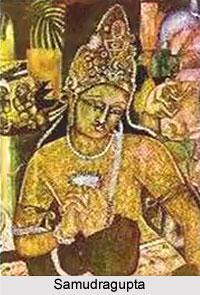 Samudragupta (reigned 350-375) was the second emperor of the Gupta dynasty of India. His reign ushered in the Golden Age in India and he is remembered both as a benevolent imperial conqueror and a patron of arts and letters. During his ascension to the Indian throne, the Guptas existed as the local powers in the Gangetic valley. Samudragupta, through his conquests expanded the territory of the Gupta Empire to a vast extent, both in northern and southern India. The total extermination of the nine kings of the north, testifies his uncommon military skills. His brilliant power of leadership is proved by his southern conquests. The dazzling campaigns and the organisational skills of Samudragupta has led Dr. Smith to describe him as "Indian Napoleon".
Samudragupta (reigned 350-375) was the second emperor of the Gupta dynasty of India. His reign ushered in the Golden Age in India and he is remembered both as a benevolent imperial conqueror and a patron of arts and letters. During his ascension to the Indian throne, the Guptas existed as the local powers in the Gangetic valley. Samudragupta, through his conquests expanded the territory of the Gupta Empire to a vast extent, both in northern and southern India. The total extermination of the nine kings of the north, testifies his uncommon military skills. His brilliant power of leadership is proved by his southern conquests. The dazzling campaigns and the organisational skills of Samudragupta has led Dr. Smith to describe him as "Indian Napoleon".
Samudragupta was an imperialist by every inch of his body. Smith has remarked about him that though usurping a kingdom is the business of a king, yet Samudragupta did not act as a naked imperialist. Political unification of India, establishment of peace and order were the fruits of his imperialism. His Empire led to a revival of art and culture to unprecedented heights. Economic motives of trade and tribute and political motives of fortifying India`s frontier against foreign invasion lay far behind his policy of expansionism.
Harishena in Allahabad Prasasti adores Samudragupta as a man of versatile genius. Samudragupta himself was gifted with the skills of poetry and music. The mighty conqueror Samudragupta earned a thriving prosperity as a poet. Due to his composition of beautiful verses, Samudragupta was given the epithet, the "king of poets". Samudragupta`s virtue as a poet and musician stands on solid ground. Moreover in the Prasasti he is eulogised as the `shining example of philanthropy`. He patronised poets and worked for the promotion of education and learning in his Empire. Himself a great musician, Samudragupta`s passion for music is testified by his figure in his coins, carrying a lyre on his knees. He was an accomplished scholar, well versed in Shastras, and a great patron of art and letters. The Buddhist records also refer to his patronage of learning. As an administrator, he was very just and kind. Removing all discrepancies from his kingdom, Samudragupta had worked for the promotion of equality and equal opportunity of people in his Empire. He made liberal help to the poor and the downtrodden. The mighty conqueror Samudragupta was no less an administrator, with sound intellect, unusual benevolence and taste for culture.
Samudragupta ushered in a new age in the history of ancient India. He revived the Brahmanical Hinduism from relative obscurity, by the performance of horse sacrifice, which he restored again. It was also the beginning of the neo-Brahmanical doctrine, which upheld the principle of considering the king as the divine incarnation in earth. This doctrine of neo-Brahmanism is evident from the coins of Samudragupta. Moreover in two copper plates Samudragupta is referred to as "Parama Bhagavata", showing that he was a devotee of Vishnu. However Dr. Majumdar thinks that these copper plates are spurious. His reign marked the beginning of the new era, with unprecedented intellectual and material progress. Samudragupta was a pioneer among the Guptas, who initiated the "Golden Age" in the ancient history of India. As a whole, the spirit of Renaissance, which was the key feature of the age, was started during the reign of Samudragupta.
Samudragupta, the successor of Chandragupta I, was the ruler under whom the Guptas emerged the vast Imperial power, ruling the entire northern and southern India with thriving prosperity. It was Samudragupta who brought the Gupta Empire under the limelight of ancient Indian history. While describing the achievements of Samudragupta, the pioneer of Gupta Renaissance, Dr. H.C Roychowdhury has drawn an interesting comparison between Ashoka and Samudragupta. According to Dr. Roychowdhury, Samudragupta was more versatile than Ashoka. Ashoka was proficient in scriptures only, but the versatility of Samudragupta lies in the fact that Samudragupta was adept in all branches of art and culture. While Ashoka had worked for the spiritual upliftment of his subjects, Samudragupta had worked for the material welfare of the subjects, because according to Samudragupta unless the people are materially established, spiritual upliftment would do no good to them. Moreover Samudragupta, no less than Ashoka had fortified the rampart of "True Law". Samudragupta is famous in the history of ancient India, not only as a mighty conqueror, but also as a just and benevolent administrator.
Coronation of Samudragupta
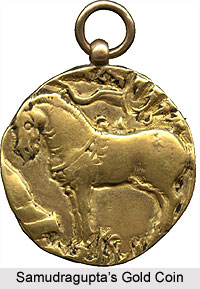 Samudragupta was the famous ruler of the Gupta dynasty, under whom Gupta Empire was destined to attain dazzling success and prosperity. Samudragupta, the son of Chandragupta I by his Licchavi queen, Kumaradevi, succeeded his father to the throne. With the ascension of Samudragupta to the throne of the Gupta Dynasty, the Guptas attained conspicuous superiority over all the important authorities and was transformed from the local powers in Gangetic valley into a pan Indian Imperial authority.
Samudragupta was the famous ruler of the Gupta dynasty, under whom Gupta Empire was destined to attain dazzling success and prosperity. Samudragupta, the son of Chandragupta I by his Licchavi queen, Kumaradevi, succeeded his father to the throne. With the ascension of Samudragupta to the throne of the Gupta Dynasty, the Guptas attained conspicuous superiority over all the important authorities and was transformed from the local powers in Gangetic valley into a pan Indian Imperial authority.
The Allahabad Prasasti composed by Harishena, delineates a vivid description of the reign of Samudragupta. In the fourth stanza, there is a vivid description of the nomination of Samudragupta as his successor, by Chandragupta I. It is described that Chandragupta declared his son Samudragupta as his successor in a full session of the royal court. The Allahabad Pillar inscription also delineates the civil war, which was the immediate result of Chandragupta`s declaration.
From the Allahabad Pillar inscription it is known that Samudragupta had to confront various obstacles after he was declared the successor of Chandragupta I. There was a difference between the ministers and royal kinsmen on account of his succession - the immediate result of which was the civil war. As is suggested in the Allahabad Prasasti, Chandragupta I abdicated the throne in favour of his son and successor Samudragupta. As a result, the other princes of equal birth, who aspired for the throne, were disappointed and they revolted against Samudragupta under the leadership of Kacha. Kacha was supposed to be the elder son of Chandragupta. It is however presumed by the scholars that the Licchavi marriage of Chandragupta had divided the Gupta court into two opposite factions. The orthodox section was against the Licchavi faction and degraded them on account of their inferior culture, in comparison to the orthodox Brahmanical culture. The Licchavis at that time was considered the `Bratyas` or the `fallen Kshatriyas`. Henceforth the nomination of Samudragupta alienated the orthodox faction in the court, who apprehended the supremacy of Bratya culture of the Licchavis in royal court. Hence they supported Kacha, the eldest son of Chandragupta I against Samudragupta, the successor of Chandragupta I.
Kacha was the advocate of superior Brahmanical culture of the Gupta dynasty. Hence he was hostile towards Samudragupta, a Licchavi descendant. But however there is a keen controversy among historians regarding the hostility of Kacha towards Samudragupta. According to S.B. Gayal, the antagonism between Kacha and Samudragupta was for idealistic causes and not individual. Kacha was impatient towards any culture apart from traditional Brahmanical culture of superior quality. This theory of Dr. Gayal can be supported from the evidences of the contemporary period. Kacha`s hostility for Buddhism can be proved from his condemnation in a Buddhist
treatise-`Arya-Manjusri-Mula-Kalpa`. Some coins bearing the name of Kacha and a Brahmi legend "Sarvarajochetta" have been found in the regions, famous as the centres of orthodox Brahmanical Culture. Therefore the resentment of Kacha for Samudragupta represented the struggle between two opposite cultures, with which the factional rivalry in court became entangled. Dr smith also corroborated the theory of Dr.Gayal and identified Kacha with the rival brothers of Samudragupta. Dr.Bhandarkar however discarded the view of Dr Gayal and Dr.Smith and identified "Kacha" with Rama Gupta. But the theory of Dr. Bhandarkar is generally discarded due to the fact that he was a cowardly man and that he could not claim the title "Sarvarajochetta". The view that Kacha was the elder brother of Samudragupta is widely accepted. It has also been suggested by modern scholars that the fragmentary stanzas of 5 and 6 in Allahabad Prasasti referred to the revolt. However Samudragupta crushed the revolt successfully. But the civil war, or the rivalry for the throne was by no means certain. Later Allan, on the basis of numismatics evidences has contended the theory of civil war and puts forward that Samudragupta and Kacha were the same person. But this theory was discarded on the basis of the different pattern of coins issued in the name of Samudragupta and that of Kacha. Nevertheless the general belief runs that Samudragupta ascended the throne after suppressing the civil war, the outcome of fraternal bitterness.
Foreign Relations under Samudragupta
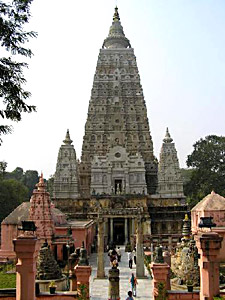 The foreign relations under Samudragupta were maintained with Later Kusanas, Sakas and with Ceylon. This foreign relation involved (i) atmanivedanam- their own persons for service to the emperor, (ii) kanyopdyanaddna (gifts of maidens) and (iii) Garutmad-anka-sva-visaya-bhukti-Msana-ydcana (applications for charters bearing the Garuda seal for the enjoyment of their own territories).
The foreign relations under Samudragupta were maintained with Later Kusanas, Sakas and with Ceylon. This foreign relation involved (i) atmanivedanam- their own persons for service to the emperor, (ii) kanyopdyanaddna (gifts of maidens) and (iii) Garutmad-anka-sva-visaya-bhukti-Msana-ydcana (applications for charters bearing the Garuda seal for the enjoyment of their own territories).
The account implies Treaties of Alliance and Service. According to the Chinese author, Wang Hiuen-tse, the king of Ceylon Sri Meghavarna had sent two Buddhist monks to Bodh-Gaya, but the pilgrims had to face great inconvenience as there was no suitable accommodation. To remove this difficulty the king of Ceylon sent an embassy with presents to Samudragupta asking for his permission to build at Bodh Gaya a monastery for the Ceylonese pilgrims. The permission was also granted instantly.
Political Condition of North India before Samudragupta`s Rise
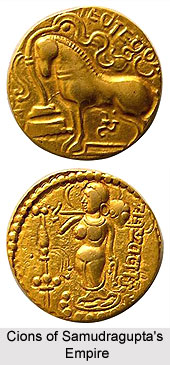 During the reign of the later Kushanas, when they had become unable to maintain the administration of such a vast kingdom, the political condition of North India was pretty anarchical. The vast Kushana Empire was disintegrated into several small provinces and the provincial chiefs unfurled the flag of independence. Among these independent states, some were autonomous tribal republics and the others, monarchical. When Samudragupta set out on his military campaign, these small provincial states offered him resistance. But they were however defeated and subjugated by him.
During the reign of the later Kushanas, when they had become unable to maintain the administration of such a vast kingdom, the political condition of North India was pretty anarchical. The vast Kushana Empire was disintegrated into several small provinces and the provincial chiefs unfurled the flag of independence. Among these independent states, some were autonomous tribal republics and the others, monarchical. When Samudragupta set out on his military campaign, these small provincial states offered him resistance. But they were however defeated and subjugated by him.
The principal source of information about the ascension and reign of Samudragupta is the Allahabad Prasasti, composed by his court poet Harishena. Information about the local kings are also available from Allahabad Prasasti. The coins and inscriptions of these local kings also throw much light on the condition of northern India and the part played by the local kings before the ascension of Samudragupta to the throne of the Gupta Dynasty.
In Uttar Pradesh and Central India there were four kingdoms standing as rivals to Samudragupta. They were- king Achyuta of Ahichchatra, Nagasena of Mathura, Ganapati Naga of Padmavati and a king of the Kota family (the name of the king is not known), who formed a formidable resistance against the powerful Gupta emperor Samudragupta. The Nagas had risen from the ruins of the Kushana Dynasty. Due to Saiva leanings of the founder king Bhavanaga, the Naga family was called Bharasivas. According to Dr. Jaiswal, the Guptas were originally feudatories of the Bharasivas. But scholars discarded the view. However these Nagas had formed a strong kingdom of their own. Henceforth Samudragupta had to fight against them to extend his Empire. Among these four kings Nagasena of Mathura and Ganapati Naga of Padmavati both belonged to the Naga clan. The Kota king ruled in Sravasti region of U.P. As historical records suggest, during that time the entire region of U.P and Central India was under the dominance of the Naga kings. However Samudragupta managed to defeat such a formidable opposition fabricated by the Naga rulers.
In Allahabad Prasasti the names of six kings who were defeated by Samudragupta is mentioned. They were Rudradeva, Matila, Nagadatta, Chandravarmana, Nandin and Balavarmana. Rudradeva is often identified with Rudradeva I of Vakataka or Western Deccan, Matila ruled in Western Uttar Pradesh, Nagadatta, Nandin and Balavarmana were the Naga descendants, who ruled in central India. Though Chandravarmana has been variously identified, it is generally believed that he was the ruler of the Bankura district in West Bengal. These small provincial kings were at continuous war against one another and the entire northern India was disintegrated and extremely chaotic. Samudragupta had to defeat these independent kings before expanding the limits of the Gupta Empire in those regions.
 Samudragupta had also led his military conquest in several other fragmented parts, which was occupied by some tribal communities and forest kings. Among these regions mention may be made of the Atavika kings or the forest kings, who ruled in the forest tracts, extending from the Ghazipore district of Uttar Pradesh to Jabbalpore in Central Province. Outside Uttar Pradesh, Bengal and Central India, there were four Pratyanta Rashtras or frontier kingdoms. Three of them i.e. Samatata or South East Bengal, Davaka or part of Assam and Kamrup or upper Assam, were included in the territory of Samudragupta. Apart from these, Allahabad Prasasti also refers to some non-monarchic tribes, who lived in the west and the southwestern fringes of Aryavarta or the proper northern India. Samudragupta crushed these tribes and earned reverence from them. Apart from these tribes, the other tribes who held small kingdoms of their own were also defeated by the mighty conqueror Samudragupta. These were the Malavas, Arjunayas, Yaudheyas, and Madrakas.
Samudragupta had also led his military conquest in several other fragmented parts, which was occupied by some tribal communities and forest kings. Among these regions mention may be made of the Atavika kings or the forest kings, who ruled in the forest tracts, extending from the Ghazipore district of Uttar Pradesh to Jabbalpore in Central Province. Outside Uttar Pradesh, Bengal and Central India, there were four Pratyanta Rashtras or frontier kingdoms. Three of them i.e. Samatata or South East Bengal, Davaka or part of Assam and Kamrup or upper Assam, were included in the territory of Samudragupta. Apart from these, Allahabad Prasasti also refers to some non-monarchic tribes, who lived in the west and the southwestern fringes of Aryavarta or the proper northern India. Samudragupta crushed these tribes and earned reverence from them. Apart from these tribes, the other tribes who held small kingdoms of their own were also defeated by the mighty conqueror Samudragupta. These were the Malavas, Arjunayas, Yaudheyas, and Madrakas.
Thus the Allahabad Pillar inscription of Harishena, depicted a vivid picture of Punjab, Rajputana and parts of Central India, which was divided into several tribal republics. However it has been pointed out by historians that though Chandragupta I was powerful enough, the actual political unification of Gupta Empire was fulfilled by Samudragupta. The Kushana kings ruled an independent suzerain outside the core of Northern India, further in the northwest. Thus northern India was divided into petty political units on the eve of Samudragupta`s conquest. Samudragupta competently had solidified the Gupta Empire with his conquest, the base of which was established by the third Gupta ruler, Chandragupta I.



















